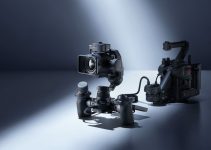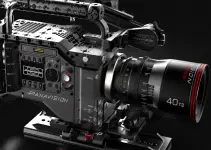Studies have shown that quite a few of us really, really like cameras. Big cameras, small cameras, very expensive cameras and somewhat less expensive cameras. Comparing two of them is a common practice, one I’m not proud to say I’ve put far too much thought into myself. “Could an A7r replace my 5D3 as a portrait camera?” “Will a client look at me funny if I charge them full rate for a video using a GH4 instead of a C300?” “Does anyone buy a C100 for reasons other than not having the extra grand for an FS700?”
I am a dork who often forgets that “28 Days Later” was shot on the Canon XL1S and has grossed well over $80 Million, but I digress.
Michael Shu and Colin Pregent of Onyx Cinema and It’s Personal Cinema respectively have combined their camera collections to perform a 4-way shootout between four of the top owner-operator cameras in the $5,000-and-under range: Canon’s EOS 5D Mark III and C100, Sony’s A7s, and Panasonic’s GH4.
This test isn’t meant to be a DxOMark inspired meticulous test of grain structure or pixel density, but rather real-world tests in three categories that are most commonly looked for by entry level and experienced shooters alike: dynamic range in high contrast shooting situations, detail in 1080p between 24fps and over-cranking, and low-light high-ISO performance. All four cameras were mounted to EF lenses thanks to Metabones adapters as a means of evening the playing field in that regard. Gentleman, start your cameras!
ROUND ONE – DYNAMIC RANGE
The 5D Mark III’s Cinestyle and C100’s Log C are Canon’s familiar attempts at 8-Bit Log. While they don’t leave the greatest amount of latitude, they produce clean images out of camera and can be improved with basic contrast and saturation shifts easily.
Unadjusted Panasonic Cinelike D proved to be far too strongly pushed for in-camera contrast and saturation, so an adjusted version was used at ISO 800 for most of the testing. It was also found that Sony’s A7s suffered from an unreliable preview screen in regards to exposure.
WINNER: Unsurprisingly, Sony’s S-Log2 was powerful enough to take home the win in dynamic range. While the C100 arguably produces the most cinematic images, it leaves very little room for professional grading.
ROUND TWO – SLOW MOTION
The GH4 and A7s come into this round better prepared with higher frame rates, while Canon’s weakness in over-cranking abilities rears it’s interlaced head. To achieve an over-cranked image with the C100, the footage was shot 60i and slowed-down in Adobe Premiere Pro by 40%. When over-cranked, the DSLRs struggled to maintain clarity in their images.
WINNER: The micro four-third GH4 may own the smallest sensor of the bunch, but it pulled out the clearest image when recorded at 60 frames per second in full HD. In second place came the mirrorless A7s, once again bringing more detail to the table than Canon’s offerings.
ROUND THREE – LOW LIGHT / HIGH ISO
To borrow a line from a fine piece of modern American cinema, “This is like if Tyson fought an infant”. For the 1600 ISO test, the A7s was unable to compete, as it’s lowest ISO for cine mode is 3200 (the former 5D2 user in me is internally screaming and throwing things…leave him be, he’ll tire out eventually). In 1600, the little-Panasonic-that-could takes the prize.
At 3200, the A7s enters the fray. At 6,400, the Micro 4/3 Panasonic bows out, having reached the top end of it’s ISO capabilities. Back to a three camera race at 12,800 ISO, none of the remaining three cameras seem to struggle much at all.
At 25,600 the C100 begins to crumble, even with this being the 5D3’s highest ISO. At 51,200 the C100 loses all usability, and at 80,000 the camera pleads for light with a sandstorm of grain. Meanwhile, in Sony-land:
Certainly the sensor in the A7s is something to behold, but overall each camera has its strengths and weaknesses in terms of not just image quality, but also ergonomics and workflow. What do you guys think of the above tests? Let us know in the comments below.
Disclaimer: As an Amazon Associate partner and participant in B&H and Adorama Affiliate programmes, we earn a small comission from each purchase made through the affiliate links listed above at no additional cost to you.
Claim your copy of DAVINCI RESOLVE - SIMPLIFIED COURSE with 50% off! Get Instant Access!






Sony has designed a camera that cover lot of the holes of the last generation Video Dsrl.
Lightness, quality of images, picture stiles, focus assist, nice audio, slowmotion, apsc mode, new codec, lowlights,4k possibility, internal viewfinder and an exellent LCD with joint make this camera, for me, a door on a new world for videomaking AT THE HALF of the PRIZE of a Canon c100.
personally:
– i dont like the look of whats coming out of the sony (graded or not)
– because im an old guy, i ENJOY working in the land of full-frame. simply because im used to it.
– as a service provider i like the deliverable latitude of in-camera 4k from the gh4.
– the c100 has what id consider the best looking image of the 4 but it doesnt do stills and is around 2x the price of the rest. so thats not really a fair comparison.
its all a matter of what you like and what you’re used to. for most non-seasoned-pros, and especially AUDIENCES, you’d really have to have the final footage side by side to notice a significant difference.
what bothers me though about tests like this is it’s really only part of the equations. there is very little motion in any of the footage. and thats where a lot of these devices (at any price) tend to fall down. moire, aliasing, judder, jello…
I don’t know but it seems that for slow motion, on the four snapshots side by side that the C100 and 5D MK3’s pictures show better definition. The opposite of what you’re saying. I am confused…
Interesting. Watching these all at full screen on an iMac 27″ I really can’t see why I would sell my C100 and Mkiii for either the Sony or the GH4. Don’t get me wrong, I like what I’ve seen on the GH4, maybe if I was starting out new I would go towards it, but the Canon both give very nice results, albeit if you need slo-mo these are not the cameras for you. Get the new iPhone 6 Plus! (G) I’ll have some tests as soon as it arrives.
The canon colors are so much more filmic and true to color than Sony / Panasonic. The c100 really needs noise reduction turned on to a setting of atleast 3-4 (out of 12) to compete with A7S, as the A7S has it in these tests. And that AVCHD codec looks horrible when zoomed in – on the 50k ISO+ side! The new C100 MK2 looks more promising with far better noise and 60p!
Most tests comparing low light with the C300 / C100 nobody ever turns on Noise reduction!! And they still perform great.